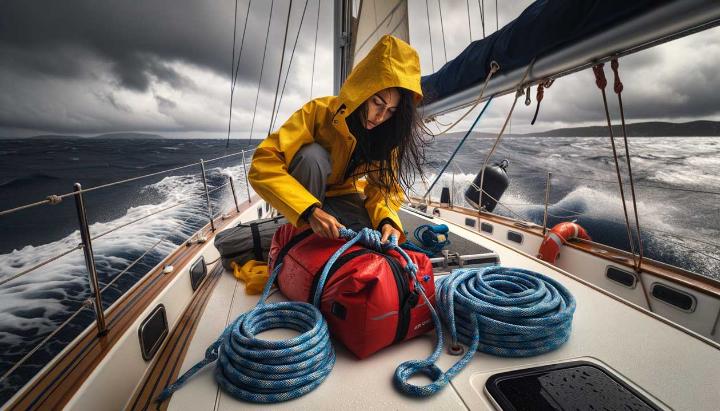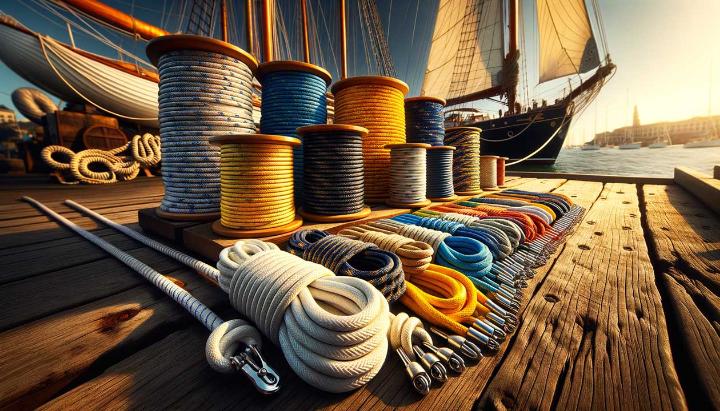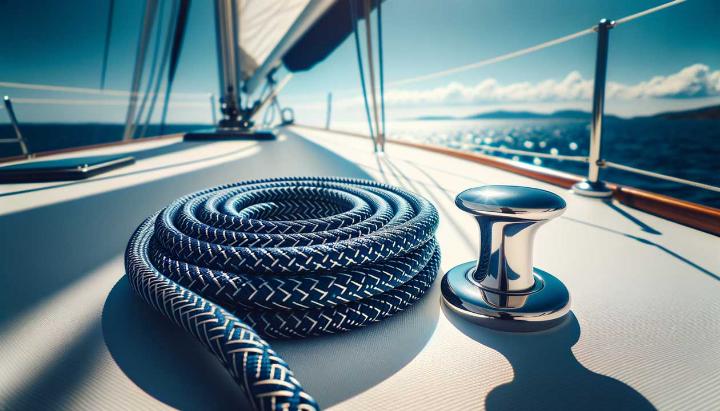Have you ever wondered why seasoned sailors swear by 6mm braided rope? It's not just about strength or flexibility—it's about mastering the art of nautical efficiency. In the world of boating and yachting, where every gram and centimetre matters, 6mm braided rope emerges as the unsung hero of maritime adventures.
From the sun-drenched decks of luxury yachts to the weathered hulls of small fishing boats, 6mm braided rope proves its worth time and time again. But what makes this seemingly simple tool so indispensable? Whether you're securing a dinghy, hoisting a sail, or crafting intricate knots, the versatility of 6mm braided rope—be it nylon, polyester, or high-tech materials like UHMWPE and KEVLAR—is truly remarkable.
In this comprehensive guide, we'll dive deep into the world of 6mm braided rope, exploring its myriad applications, material options, and customisation possibilities. From the vibrant blue ropes that catch the eye to the robust nylon variants that withstand the harshest conditions, we'll uncover why mastering the use of 6mm braided rope is essential for any serious boating enthusiast. So, hoist the mainsail and join us on this journey to unlock the full potential of this maritime marvel!
Understanding the Versatility of 6mm Braided Rope
When it comes to boating and yachting, choosing the right rope can make all the difference in your maritime adventures. That's where 6mm braided rope comes into play, offering a perfect balance of strength, flexibility, and versatility that's hard to beat. As an avid sailor myself, I've come to appreciate the many applications of this maritime workhorse.
Strength and Applications of 6mm Braided Rope
One of the most impressive features of 6mm braided rope is its remarkable strength-to-weight ratio. With a breaking strain of approximately 550kg, this lightweight rope punches well above its weight class. To put that into perspective, it's strong enough to tow a small dinghy or secure heavy equipment on deck, yet light enough to handle with ease.
- Towing and mooring: Perfect for securing small boats and dinghies to docks or larger vessels.
- Rigging: Ideal for halyards and sheets on smaller sailboats, providing smooth operation through pulleys.
- Strapping down loads: Secures gear and equipment on deck, keeping everything shipshape during rough seas.

Comparing 6mm Braided Rope to Other Rope Types
When you're out on the water, every bit of weight and space matters. That's why 6mm braided rope often outshines its counterparts:
- Diameter comparison: 6mm strikes the sweet spot between the too-thin 4mm and the bulkier 8mm or 10mm options.
- Flexibility advantage: Unlike laid rope, braided construction offers superior flexibility without compromising strength.
- Material matters: Polypropylene is a popular choice for its buoyancy and resistance to mildew, while Dyneema offers unparalleled strength for its weight.
Have you ever wondered why some ropes float while others sink? It's all about the material. Polypropylene 6mm braided rope floats, making it perfect for water rescue situations or as a floating line for your anchor.
Pro tip: When choosing between polypropylene and nylon 6mm rope, consider your specific needs. Polypropylene floats and resists rot, while nylon offers more stretch and UV resistance.
In my years of sailing, I've found that having a variety of 6mm braided ropes on board, each suited for different tasks, has been invaluable. Whether you're securing fenders, setting up a clothesline, or creating a temporary lifeline, this versatile rope is up to the task.
So, next time you're outfitting your boat or yacht, give 6mm braided rope a try. Its versatility might just surprise you, making your time on the water safer, more efficient, and more enjoyable. After all, isn't that what boating is all about?
Exploring Material Options for 6mm Braided Rope
As a seasoned sailor, I've learned that choosing the right material for your 6mm braided rope can make or break your nautical experience. Let's dive into the world of rope materials and explore how they can impact your time on the water.
Common Materials for 6mm Braided Rope
When it comes to 6mm braided rope, we're spoilt for choice. Each material brings its own unique set of properties to the table, affecting everything from strength to how it feels in your hands on a chilly morning at sea.
- Nylon: The all-rounder of the rope world. It's strong, stretchy, and absorbs shock like a champ. Perfect for mooring lines and anchor rodes.
- Polyester: Less stretch than nylon, but extremely UV resistant. Ideal for halyards and sheets where you need minimal elongation.
- Polypropylene: The floater of the bunch. Light, water-resistant, and budget-friendly. Great for temporary lines or water safety applications.
But wait, there's more! For those seeking cutting-edge performance, high-tech synthetic fibres like UHMWPE, TECHNORA, KEVLAR, VECTRAN, and SPECTRA are pushing the boundaries of what 6mm rope can do.

Comparing Synthetic and Natural Fibres
While synthetic fibres dominate the marine rope market, natural fibres like cotton, hemp, and manila still have their place. Here's a quick comparison:
| Property | Synthetic Fibres | Natural Fibres |
|---|---|---|
| Strength-to-Weight Ratio | High | Low |
| UV Resistance | Excellent (especially polyester) | Poor |
| Moisture Absorption | Low | High |
| Durability | High | Moderate |
So, when should you opt for natural over synthetic? If you're after that classic nautical aesthetic or working with traditional rigging, natural fibres might be your go-to. But for most modern applications, synthetics will serve you better.
Pro tip: For 6mm braided rope on small boats and yachts, nylon is often the sweet spot. It offers a great balance of strength, durability, and shock absorption. Just remember to factor in its tendency to stretch when wet!
Choosing the right 6mm braided rope material boils down to understanding your specific needs. Are you looking for something to handle heavy loads, resist UV damage, or provide a soft touch? By matching the material properties to your requirements, you'll ensure your 6mm rope performs at its best, keeping you safe and efficient on the water.
Have you experimented with different rope materials on your vessel? I'd love to hear about your experiences in the comments below. After all, sharing knowledge is what helps us all become better sailors!
Customization Possibilities with 6mm Braided Rope
As a seasoned sailor and rope enthusiast, I've come to appreciate the incredible versatility of 6mm braided rope. But what truly sets it apart is its potential for customization. Let's explore how you can tailor this maritime workhorse to suit your specific needs and style preferences.
Versatile Applications of 6mm Braided Rope
The beauty of 6mm braided rope lies in its adaptability. From essential marine tasks to creative DIY projects, this rope can do it all. Here are some ways you can customize it for various applications:
- Marine use: Customize the length and end treatments for perfect mooring lines, halyards, or sheet ropes.
- Outdoor adventures: Create custom-length guy lines for tents or hanging systems for hammocks.
- Home DIY: Craft unique handrails, decorative knot work, or even stylish rope furniture.
I once used a length of customized 6mm blue rope to create a striking nautical-themed room divider in my beach house. The vibrant colour and intricate knotwork never fail to impress visitors!

Strength and Durability Features
When it comes to customizing 6mm braided rope, understanding its strength characteristics is crucial. With a breaking strain of approximately 550kg, this rope offers impressive capabilities for its size.
Different materials provide unique benefits:
- Nylon: Excellent for applications requiring stretch and shock absorption.
- Polyester: Ideal when you need minimal stretch and maximum UV resistance.
- Polypropylene: Perfect for projects where lightweight and water resistance are key.
For more specialized needs, high-performance materials like UHMWPE, TECHNORA, KEVLAR, VECTRAN, and SPECTRA offer exceptional strength-to-weight ratios and unique properties.
Remember, the customization process can affect the rope's performance. For instance, adding a protective sleeve might slightly reduce flexibility but greatly enhance abrasion resistance. It's all about finding the right balance for your specific application.
Pro tip: When customizing 6mm braided rope for critical applications, always factor in an appropriate safety margin. It's better to err on the side of caution when it comes to load-bearing tasks. For those interested in tailored solutions, check out iRopes' customized ropes and accessories to meet diverse needs.
Have you ever customized rope for a unique project? I'd love to hear about your experiences and creative ideas in the comments below. Let's inspire each other to push the boundaries of what's possible with 6mm braided rope!
Mastering 6mm Braided Rope: Use and Maintenance
As a seasoned sailor, I've learned that the key to a safe and enjoyable boating experience often lies in the details - and one of those crucial details is how you handle your 6mm braided rope. This versatile workhorse of the nautical world deserves proper care and attention. Let's dive into the essentials of using and maintaining your 6mm braided rope to ensure it serves you well for years to come.
Properties and Applications of 6mm Braided Rope
Before we delve into maintenance, it's important to understand what makes 6mm braided rope so special. With a breaking strain of approximately 550kg, this lightweight champion punches well above its weight class. Its balanced blend of strength and flexibility makes it ideal for a variety of marine applications:
- Towing and mooring: Perfect for securing small boats and dinghies.
- Rigging: Excellent for halyards and sheets on smaller sailboats.
- Load securing: Ideal for strapping down gear and equipment on deck.
The versatility of 6mm braided rope extends beyond its strength. Its UV-resistant properties and low stretch characteristics make it a reliable choice for long-term use in marine environments. To explore more about high-performance marine ropes, you can read the article Choosing the Best Marine Braided Rope for Your Needs.

Essential Rope Care Techniques for Longevity
Proper care can significantly extend the life of your 6mm braided rope. Here are some techniques I've found invaluable over the years:
- Storage is key: Always store your rope in a cool, dry place away from direct sunlight. UV rays can degrade the fibres over time.
- Gentle cleaning: After use, especially in saltwater, rinse your rope with fresh water. For a deeper clean, use mild soap and lukewarm water, then air dry completely.
- Regular inspections: Check your rope for signs of wear, such as fraying or discolouration. Pay special attention to areas that experience the most friction.
- Proper coiling: Learn to coil your rope correctly to prevent kinks and tangles. The figure-eight coil is a sailor's best friend!
I remember a time when I neglected to rinse my 6mm braided rope after a particularly salty voyage. The crystallised salt acted like tiny knives, abrading the fibres over time. It was a costly lesson in rope care that I've never forgotten.
Pro tip: Never store a wet rope! Moisture can lead to mildew and rot, significantly weakening the fibres. Always ensure your 6mm braided rope is completely dry before storage.
Safety Considerations When Using 6mm Braided Rope
While 6mm braided rope is incredibly strong for its size, it's crucial to use it safely:
- Know your limits: Always work within the rope's safe working load, which is typically about 10-15% of its breaking strain.
- Master your knots: Learn and practice essential knots like the bowline, clove hitch, and figure-eight. The right knot can make all the difference in a critical situation.
- Regular replacements: Even with proper care, ropes have a lifespan. Replace your 6mm braided rope every few years or sooner if you notice significant wear.
- Avoid sharp edges: Use chafe guards or fair leads to protect your rope from abrasion against rough surface. You can also explore iRopes' custom chafe protection solutions to extend your rope's life.
Have you ever found yourself in a situation where your rope knowledge made a crucial difference? I'd love to hear your stories and tips in the comments below. After all, sharing our experiences is how we all become better, safer sailors.
Remember, mastering the use and maintenance of your 6mm braided rope isn't just about preserving your equipment - it's about ensuring your safety and enjoyment on the water. So treat your rope well, and it will return the favour when you need it most!
Explore Custom 6mm Braided Rope Solutions for Your Boat
Embrace the versatility and strength of 6mm braided rope for your boats and yachts. Our 6mm blue rope and 6mm nylon rope options provide the ideal balance of flexibility and durability, suitable for a range of applications from mooring to rigging. With customization possibilities, including different materials like UHMWPE, TECHNORA, KEVLAR, VECTRAN, and SPECTRA, as well as various colours and diameters, your options are limitless. Proper care and maintenance ensure your rope performs optimally, extending its life for your maritime adventures. Fill in the form above to learn more about our customized rope solutions tailored to meet your specific needs.